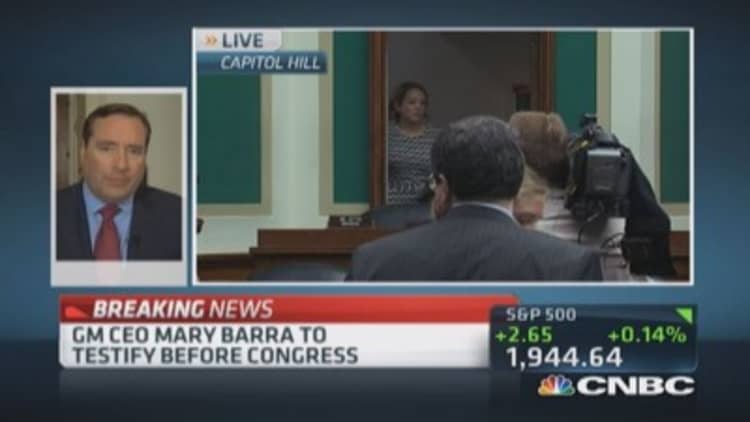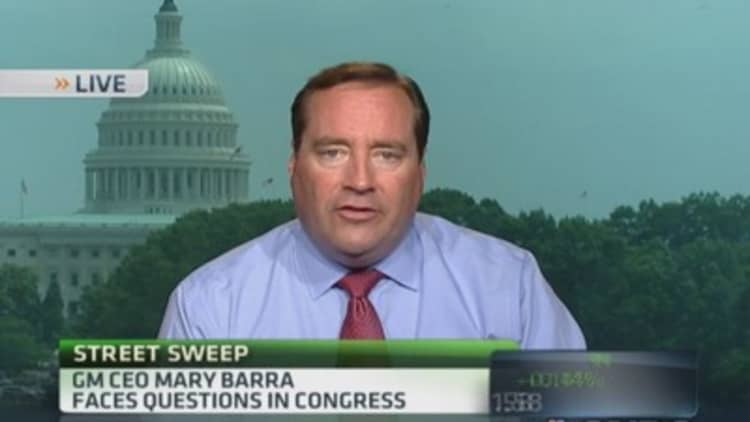Mykia Jordan has no memory of the car accident that put her in a coma for three weeks, left a large scar across her jaw and caused the limp that forces her to walk with a cane at 23.
She only knows what the police and others told her — that in the middle of a Sunday afternoon, with her 3-month-old son strapped in a car seat, she lost control of her Chevrolet Cobalt on a freeway ramp in Detroit. It crashed into a cement barrier and overturned, crushing the roof around her. The air bags did not deploy.
Read MoreGM recalls 3.36 million cars for ignition issues
She missed a year of work and school while she recovered from a head injury and many broken bones, breathing through a tracheostomy tube and relearning how to walk. The baby survived with hardly a scratch, remarkable fortune that she says helps blunt the pain she still feels in her leg every day.
Lawyers and investigators now believe Ms. Jordan's accident, on Oct. 14, 2012, was the fault of a defective ignition switch in Cobalts and several other models of General Motors cars.
As such, Ms. Jordan personifies the next challenge in a safety crisis that has led G.M. to recall 2.6 million vehicles after years of inaction: how to deal with hundreds of injury claims that the company has refused to discuss or characterize. Some experts predict the cost to the company could run into the billions of dollars, exceeding the payouts related to deaths linked to the defect.
Kenneth R. Feinberg, the victim-compensation expert hired by the company, is nearing the final stages of an elaborate process to determine who is eligible for payments and for how much. His plan, which is expected to be made public in the next two weeks, is seen as critical to the company's ability to move beyond an issue that has prompted numerous investigations, congressional hearings, a $35 million federal penalty and withering public criticism.
While it will not come cheap, getting the payment plan right is crucial. Too generous and it could slow the automaker's comeback from bankruptcy; not generous enough and victims will seek justice through lengthy and costly court battles, further dragging out the company's turmoil.
Read MoreExplosion risk: Honda, Mazda, Nissan recall vehicles
Claims records, lawsuits and accident reports suggest that the list of injured survivors is long and tragic.
It may include a paralyzed boy, now 6, whose great-grandmother and 13-year-old aunt died in the crash, and a young man whose dreams of joining the Marines ended when his Cobalt suddenly stalled and flipped, leaving him paraplegic. A 28-year-old woman has filed suit in Indiana seeking compensation for a Cobalt accident that left her with disfiguration so severe that she has gone through eight facial reconstruction surgeries, with more to come. Her boyfriend, who was driving and joined her in the lawsuit, lost his right eye.

"I would like to see a settlement," said Ms. Jordan, whose crash occurred less than five miles from G.M.'s world headquarters and whose mother once worked for the company. "I was out of work. I missed so much of my son's developmental growth while I was in the hospital. I had to have my face reconstructed. And my leg just hurts."
Though G.M. has been silent about victims, at least one case clearly is on the company's radar. In a recent filing with the Securities and Exchange Commission, G.M. listed among potential liabilities from the recall a lawsuit filed by the family of Haley Elise Van Pelt, who was 17 when she suffered what the court complaint describes as a "catastrophic brain injury" in the crash of her 2003 Saturn Ion, leading to more than $1 million in medical bills so far. Her family declined to comment.
Though much of the public outcry over the defective switch has focused on the fact that people died, it is these sorts of catastrophic injuries that have historically resulted in the biggest payments, lawyers note.
Read More Cramer says buy GM into 'teeth of recall'
"Those very serious life-altering injuries generally bring more money than wrongful death," said Douglas Laycock, a law professor at the University of Virginia who specializes in damages. Each case, he said, "can be many, many millions."
G.M. has publicly linked 54 accidents and 13 deaths to the ignition defect, but its injury tally remains a mystery. The company has declined to provide regulators with injury figures, and Mary T. Barra, the chief executive, would not give a ballpark figure when asked at Wednesday's congressional hearing. A G.M. spokesman, Greg Martin, said the company would not comment on specific accidents, primarily to protect the privacy of victims.
Financial settlements for accident survivors are usually calculated by looking at a mix of medical expenses both for immediate treatment and a lifetime of continuing care, the wages that the victims would have made over their lifetime had they not been injured and the harder-to-measure factor of pain and suffering.
G.M. has an interest in seeing as many injury cases as possible handled not by the courts but through the compensation fund, which will begin reviewing claims Aug. 1. To that end, Ms. Barra has indicated the fund would not employ a distinction that the company has used to battle scores of other lawsuits — a provision in the company's July 10, 2009, restructuring agreement that essentially created a "new G.M." that was insulated from liability claims stemming from events before that date.
G.M. lawyers recently signaled that they would use that protection aggressively to battle those who shun the fund and proceed with litigation. They did just that this month in a response to a suit filed against the company by the family of Trenton Buzard, a 6-year-old boy who was critically injured a week before his first birthday in an April 2009 accident that killed his great-grandmother and teenage aunt. The boy spent nearly a year in a children's hospital and today is paralyzed from the waist down.
In a petition to dismiss the case, G.M. argued that the family had no standing because the defective car, a 2005 Cobalt, was not made by the G.M. that exists today. "G.M. did not design the vehicle, did not manufacture or assemble the vehicle, did not sell or warrant the vehicle," the company's lawyers wrote.
Read More Failure to Recall: Investigating GM
In anticipation of the announcement by Mr. Feinberg, the compensation expert hired by G.M., lawyers for hundreds of clients are now preparing their claims — some likely frivolous but others undoubtedly not.
The faulty switch can suddenly shut down power in a moving car, impeding critical control systems like power brakes and power steering and disabling air bags. That is what black-box data indicates happened in October 2012 to Josh Cull and Samantha Zollman, a couple in their 20s who were driving home on a rural Indiana road after having lunch with Ms. Zollman's mother.

Mr. Cull, who was at the wheel and says he does not remember the accident, ran off the road, could not correct and crashed head-on into a culvert. The air bags did not deploy and an analysis of black box data later showed that the ignition had moved into the "off" position, their lawyer, Mike Andrews, said.
Mr. Cull suffered a head injury and fractured vertebrae and lost his right eye. Ms. Zollman is still undergoing facial reconstruction surgeries — she has had eight so far. They have not been able to work since the accident, and their relationship has ended.
Jacqueline Gilbert was 25 when she lost control of her Cobalt on a highway near Shippensburg, Pa., in May 2012 and ran into a pole. Doctors diagnosed a traumatic brain injury, along with broken bones. She was in a coma for several weeks.
Ms. Gilbert had been pursuing her second bachelor's degree, in psychology, but after the accident she needed intensive daily therapy to practice speaking, walking, assembling simple puzzles and making grocery lists. "I had to train my brain to do basic things again," she said.
She has since managed to finish her degree and has recently begun working at the very rehabilitation center in Philadelphia where she recovered. But, she said, "Two years later, I've gotten faster at remembering and putting things together, but I'm nowhere near functioning at a complete pace."
While Ms. Gilbert is working to get her life plans back on track, Jesse Fortner has had to put his plans of becoming a Marine aside. On an April night two years ago in Greenfield, Tenn., Mr. Fortner's Cobalt suddenly stopped working as he drove home from grabbing food at a Sonic Drive-In. "I lost everything — brakes, steering, everything just cut off," Mr. Fortner, now 21, said. "I just remember the sounds of tires and glass breaking."
The last thing he can recall of the crash, he says, is his car smacking into an embankment before it began to roll over and over, finally resting in a ditch, wheels in the air. His air bag did not deploy. Later, in a hospital, a doctor told him he would never walk again.

Mr. Feinberg has a reputation of setting stark formulas based on the pot of money available over all. With the $80 million fund for victims of the Boston Marathon bombings last year, for example, he concluded that people who lost both legs were entitled to $2.195 million, the same value as a death. Those with one leg amputated received $1.195 million. A hospital stay of more than a month brought $950,000, regardless of the patient's health insurance coverage; stays of one or two nights brought $125,000.
The Boston fund had to rely on donations from the public. G.M.'s pockets are considerably deeper. The automaker, revitalized after its 2009 bankruptcy restructuring and $49 billion federal bailout, had $27 billion in cash reserves at the end of the first quarter. In the one corporate fund that Mr. Feinberg has overseen — for BP, following the explosion of its oil rig in the Gulf of Mexico in 2010 — the company put up $20 billion.
Read MoreGM hit with $10 billion lawsuit saying recalls damaged brand
His past work suggests that Mr. Feinberg is likely to find anyone who has been treated in the hospital for accidents they can prove involved a defective car eligible for compensation. As a first threshold, according to those familiar with Mr. Feinberg's deliberations, anyone whose air bags deployed will not be eligible.
But the burden of proof is likely to be less onerous than what is required in a court of law. "What they will almost certainly do is set up some simple procedure run by folks in Feinberg's office," said Mr. Laycock, the law professor, who has followed Mr. Feinberg's work over the years. "It will probably be a fairly objective checklist. Did you have one of these switches in your car? What are the accidents caused by ignition switch like? Was yours like that?
"The principal purpose of this type of fund is to greatly reduce litigations costs," he explained. "They want it very simple, very inexpensive."
—By Hilary Stout, Bill Vlasic, Danielle Ivory, and Rebecca R. Ruiz, The New York Times

